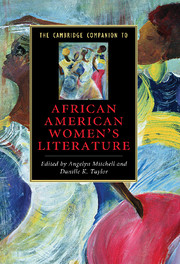Book contents
- Frontmatter
- Introduction
- Part 1 History, contexts, and criticism
- Part II Genre, gender, and race
- 6 African American women and the United States slave narrative
- 7 Autobiography and African American women’s literature
- 8 “Even some fiction might be useful”: African American women novelists
- 9 African American women poets and the power of the word
- 10 African American women in the performing arts
- 11 African American women writers of children’s and young adult literature
- 12 African American women essayists
- 13 African American women writers and the short story
- 14 African American women writers and popular fiction: theorizing black womanhood
- Bibliography
- Index
10 - African American women in the performing arts
from Part II - Genre, gender, and race
Published online by Cambridge University Press: 28 July 2009
- Frontmatter
- Introduction
- Part 1 History, contexts, and criticism
- Part II Genre, gender, and race
- 6 African American women and the United States slave narrative
- 7 Autobiography and African American women’s literature
- 8 “Even some fiction might be useful”: African American women novelists
- 9 African American women poets and the power of the word
- 10 African American women in the performing arts
- 11 African American women writers of children’s and young adult literature
- 12 African American women essayists
- 13 African American women writers and the short story
- 14 African American women writers and popular fiction: theorizing black womanhood
- Bibliography
- Index
Summary
When I write about place, I'm writing about family, about us, still trying to rebuild and redefine our families after the ravages of enslavement. I'm still trying to create a place that feels like home when we are so far from home.
(Pearl Cleage)Each of us is our own author, director, producer and star. In each moment, we have the power, the unalienable right to alter our actions and reinterpret the circumstances of our lives. In each moment, we have the freedom to speak, write and invent our own scripts.
(Barbara Ann Teer; emphasis added)Introduction
Throughout the history of performing arts, self and community have been inextricably linked to African American women's incessant search to find the place they needed, and, as black women, were not allowed to have in North American society. Angela Davis's use of the term “aesthetic community of resistance” can apply to the alternative and transformative models presented by African American women playwrights and performers within a range of womanist sites built in their works. After the 1970s, when the black women's artistic movement grew especially strong, the community of black women began to expand into what today can be considered a pan-African movement that includes African American, African, and Caribbean as reflected in these women's creations for the stage.
When referring to African American women in the performing arts, Lorraine Hansberry and Alice Childress (playwrights) or Katherine Dunham (dancer/choreographer) would probably be the first names that come to mind as forerunners of contemporary female playwrights and performance artists.
- Type
- Chapter
- Information
- The Cambridge Companion to African American Women's Literature , pp. 187 - 209Publisher: Cambridge University PressPrint publication year: 2009



